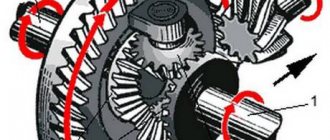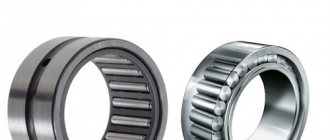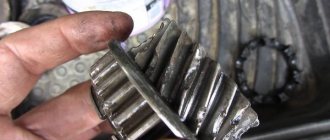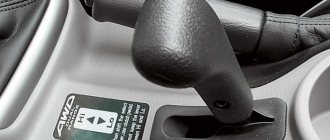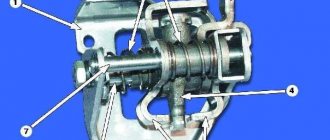A modern car is a whole complex of various technical and engineering solutions. Thanks to the coordinated work of all units, devices and mechanisms of various types, it is ultimately possible to obtain a reliable, economical and comfortable vehicle.
As you know, the main components of a car are considered to be the power unit and transmission. In fact, the engine produces the power while the transmission converts the torque and sends it to the wheels.
At the same time, an important element in the design of many cars is the hypoid transmission. Next, we will talk about what hypoid gears are, what types of such gears there are, how such a gear works, and what are the pros and cons of such a solution.
Application
What is an engine crankcase in a car?
Hypoid gears are used:
- for driving drive axles of cars, tractors, railway cars and locomotives;
- in the drives of dynamos of railway passenger cars from the wheel axles. In this case, the hypoid transmission is accelerating (gear ratio ranging from 1/2.5 to 1/4 with a transmitted power of 25-25 kW);
- for precise transmission of rotation in mechanisms, machines and machine tools, for example, in automatic gear cutting machines, since they have a large number of teeth in mesh at the same time;
- in instrument making.
In passenger cars, the widespread use of hypoid gears is explained not only by their increased load capacity and smoother operation compared to bevel gears, but also by the fact that due to the hypoid displacement of the gear axis relative to the wheel, the body can be positioned lower and thereby reduce the position of the vehicle’s center of gravity in in general.
How to choose
There are a considerable number of hypoid gearboxes on the market. These are well-known companies, and vice versa. So how do you choose a mechanism? A qualified employee will help with this. Incorrect calculations can cause damage to the gearbox and related equipment. A competent choice of gearbox will help to avoid further costs for repairs and the purchase of new equipment. The main characteristics for choosing a gearbox are its dimensions or standard size, gear ratio and kinematic diagram.
As a rule, a gearbox with a hypoid transmission lasts 10-15 years. Nowadays it is difficult to buy a “bad” mechanism that will last less. This is due to similar production technologies.
You can rely on the price, because, as is commonly believed, the more expensive the better. However, more often than not you overpay for the brand rather than for quality. After all, almost all hypoid gearbox housings are made of durable aluminum, and the shaft hangers are made of casting or steel. But, since complex technologies are used to manufacture hypoid gearboxes, their cost is quite high.
Advantages
What are its advantages compared to the other two types of gears? Among the main ones, masters highlight its almost silent operation (due to the fact that several teeth are simultaneously engaged) and greater strength (the average diameter of the gear is increased) compared to the canonical gear.
This is achieved due to the arrangement of the gears: not intersecting, but intersecting. In addition, the load experienced by one tooth is reduced, making the operation of all gears more reliable and durable.
Cars that use hypoid transmission are distinguished, among other things, by stability and smoothness. These characteristics for car enthusiasts play almost a primary role when choosing an “iron horse”, and are always under special control by automobile concerns, which are constantly improving in the direction of improving not only the “brain” of the car, but also ride comfort.
Therefore, you can most often see the hypoid version in luxury cars. Such as “Infinity”, “Lexus”, etc. Moreover, the teeth of a hypoid gear are characterized by greater resistance to fatigue when compared with a bevel gear. But where there are pros, there are also cons.
Is it possible to mix transmission fluids?
To understand this issue, you need to understand that even oils that have similar performance properties and are produced by the same manufacturer may have different chemical compositions. So, for example, in the general case, such materials can be made on a mineral or semi-synthetic basis. The composition of the additives used is even more diverse. When mixing oils of different brands, these components can interact with each other and enter into chemical reactions. The products of these reactions change, sometimes radically, the original properties of the original oils.
Most often, the combination of different oils leads to increased foaming of the product, which significantly worsens lubrication parameters and leads to increased heating of transmission components.
Thus, it is better to refrain from mixing oils of different groups. In exceptional cases, you can add oil of the same classification group.
Read also: How to_make_burgundy_color_from_gel_varnish
General information
The main gear with a differential and axle shafts drives the drive wheels, the schematic diagram of which depends on the type of suspension guide device (Fig. 1).
Fig.1. Drive to the driving wheels of the vehicle:
A
– with a rigid beam;
b
– with a sprung main gear and an additional rigid axle;
c
– with sprung main gear and independent suspension.
In the case of a solid bridge beam (Fig. 1- a
) the main gear housing can be attached directly to the beam or be its integral part, and the axle shafts are shafts that are fully or partially relieved from lateral forces from the wheels. This scheme has become widespread due to the simplicity and low cost of the design. However, in this scheme there are large unsprung masses, which leads to increased inertial loads on the elastic and shock-absorbing suspension components.
The final drive housing can be mounted on the frame or base of the supporting body. The bridge beam ensures parallel and coaxial arrangement of the wheels (Fig. 1- b
). The axle shafts do not experience lateral forces and are shafts with two cardan joints. The axle shafts must have a sliding spline connection to compensate for changes in the distance between the hinges with relative movements of the bridge and frame. In such designs, while maintaining the dependent suspension, the mass of unsprung parts is reduced.
The main gear housing can be mounted on the frame, and the wheels move independently of one another (Fig. 1- c
). Depending on the suspension design, the wheel can move parallel to the plane of symmetry of the car or swing in an arc relative to a fixed axis intersecting with the axis of the main gear. In the first case, the axle shafts do not experience lateral forces and are shafts with two cardan joints, and in the second case, the axle shafts usually carry a lateral load and have one universal joint, the center of which is located on the swing axis of the wheel.
The final drive with differential and axle shafts must meet the following requirements
:
- provide gear ratios corresponding to optimal traction qualities and fuel efficiency;
- maintain kinematic coordination with the suspension guide device, and in the case of a steered drive axle, with the steering drive;
- ensure low noise levels;
- do not create angular velocity fluctuations in the transmission;
- have small overall dimensions to allow a simple layout and provide the necessary ground clearance;
- have sufficient strength and rigidity with minimal weight.
What parameters must hypoid oil satisfy?
It is impossible to say unequivocally what criteria a hypoid gear oil must meet. A good lubricant is one that is suitable for the operating conditions of a particular unit or unit. The criteria for selecting oil are determined individually by the car manufacturer, since all brands and even car models differ from each other.
Each car has its own design features, so they require a certain class of lubricant. The design and operating conditions of the hypoid transmission of one vehicle may differ markedly from a unit similar in purpose to another vehicle. Multiple factors are important here, including:
- torque;
- axis offset;
- rotational speed;
- impact force and much more.
Thus, if GL-4 fluid is optimal and recommended for a certain unit, then it may not be suitable at all for another transmission. Thus, when selecting hypoid oil, study the vehicle's owner's manual.
Primary requirements. Modern tendencies
The main gears are subject to many requirements, the main ones being:
- Reliability;
- Minimal maintenance required;
- High efficiency indicators;
- Smooth and silent;
- Minimum possible overall dimensions.
Naturally, there is no ideal option, so designers have to look for compromises when choosing the type of final drive.
It is not yet possible to abandon the use of final drives in transmission designs, so all developments are aimed at increasing performance indicators.
It is noteworthy that changing the operating parameters of the gearbox is one of the main types of transmission tuning. By installing gears with a changed gear ratio, you can significantly influence the dynamics of the car, maximum speed, fuel consumption, load on the gearbox and power unit.
Finally, it is worth mentioning the design features of dual-clutch robotic gearboxes, which also affects the final drive design. In such gearboxes, paired and unpaired gears are separated, so there are two secondary shafts at the output. And each of them transmits rotation to its own drive gear of the main gear. That is, in such gearboxes there are two driving gears, and only one driven gear.
DSG gearbox diagram
This design feature allows you to make the gear ratio on the gearbox variable. To do this, only drive gears with different numbers of teeth are used. For example, when using a number of unpaired gears, to increase traction, a gear is used that provides a larger gear ratio, and the gear of a paired row has a lower value of this parameter.
The main gear of a car is a transmission element, in the most common version, consisting of two gears (driven and driven), designed to convert the torque coming from the gearbox and transmit it to the drive axle. The design of the main gear directly affects the traction and speed characteristics of the vehicle and fuel consumption. Let's consider the device, principle of operation, types and requirements for the transmission mechanism.
Advantages of hypoid transmission
What are its advantages compared to the other two types of gears? Among the main ones, masters highlight its almost silent operation (due to the fact that several teeth are simultaneously engaged) and greater strength (the average diameter of the gear is increased) compared to the canonical gear.
This is achieved due to the arrangement of the gears: not intersecting, but intersecting. In addition, the load experienced by one tooth is reduced, making the operation of all gears more reliable and durable.
Read also: What to do if you don’t want to live
Cars that use hypoid transmission are distinguished, among other things, by stability and smoothness. These characteristics for car enthusiasts play almost a primary role when choosing an “iron horse”, and are always under special control by automobile concerns, which are constantly improving in the direction of improving not only the “brain” of the car, but also ride comfort.
Therefore, you can most often see hypoid transmission in luxury cars. Such as “Infinity”, “Lexus”, etc. Moreover, the teeth of a hypoid gear are characterized by greater resistance to fatigue when compared with a bevel gear. But where there are pros, there are also cons.
What is hypoid oil?
Hypoid oil is a lubricant designed for extremely high mechanical loads. Accordingly, this fluid is created for the specific operating conditions inherent in hypoid gears.
Hypoid gears transmit torque by meshing a pair of gears with curved or oblique teeth. These gears are less noisy during transmission operation and can operate for a long time without wear, provided that a suitable fluid is used to lubricate them - hypoid oil.
Between the teeth of hypoid gears, the engagement area is limited to a small contact patch, but all the force is concentrated pointwise. Due to this, the specific pressure at a specific point increases greatly. This can lead to scoring, which is dangerous for the gears. To avoid this, a good hypoid oil is required that maintains a reliable film at the contact points. Due to this film, the parts come into contact with a minimum coefficient of friction.
What you need to know about hypoid oils?
As already mentioned, hypoid gears are used in the final drives of many modern vehicles. Experienced motorists are well aware of it, about which we had a separate detailed article. This fluid was previously used by the owners of all domestic cars, but when foreign cars began to actively appear in the country, the range of transmission fluids began to grow rapidly.
The main characteristic of hypoid gearbox oils is their viscosity. Today, all lubricant manufacturers, including domestic ones, have switched to the SAE classification - it is used all over the world. This classification includes seven viscosity classes, including three summer and four winter.
Winter oils are additionally marked with the letter W:
- SAE70W;
- SAE75W;
- SAE80W;
- SAE85W.
As for summer classes, a letter is not added to them, but they are marked as follows:
- SAE90;
- SAE140;
- SAE250.
It should be noted that seasonal oils rarely exhaust their service life over the winter or summer, so their use is not the most rational. In this regard, all-season hypoid fluids that are double marked as SAE80W-90 are more common among motorists.
With the exception of viscosity class, all transmission fluids are divided according to API characteristics - from GL-1 to GL-6. The higher this class, the more additives there are in the oil that support the operation of the mechanical unit. As for hypoid oils, they fall into one of three classes GL-4, GL-5 or GL-6.
Gearboxelectric motor
KM 063 V - 20.25 - FA1 - SS1 - 71B5 B3 - 0.37-4P / 1
| KM | 063 V | 20.25 | FA1 | SS1 | 71B5 | B3 | 0.37-4P | / 1 |
| 1 | 2.1; 2.2 | 3 | 4 | 5 | 6 | 7 | 8 | 9 |
| № | Decoding | Comments |
| 1 | Series designation: KM | Code for gear units series: KM |
| 2.1 | Size 050, 063, 075, 090, 110, | Specification code of gear units 050 063 075 090 110 |
| 2.2 | B: 2-stage C: 3-stage | 1 .B:Means 2 stages 2.C:Means 3 stages |
| 3 | Gear ratio | Speed ratio of reducer i |
| 4 | No marking means no output flange 2.FA,FB,FC,FD,FE(1/2) | 1 .No mark means without output flange 2.FA4 FB4 FC4 FD4 FE(1/2):output Flange and position |
| 5 | No marking means no output shaft. SS(1/2) output shaft on one side DS - double-sided output shaft. | 1 .No mark means hole output 2.SS(1/2):Single output shaft and position 3.DS:Double output shaft |
| 6 | 1. Dimensions of the input (motor) flange 2. HS indicates the presence of a high-speed input shaft | 1.Input flange code(63B5s 71V5ch 71B14) 2.HS:means shaft input |
| 7 | Location option (installation method) | Installation position code |
| 8 | 1.No marking means no motor 2. Motor power and number of poles | 1.No mark means without motor 2.Model motors(poles of power) |
| 9 | Electric motor terminal box location option | Position diagram for motor terminal box default position 1 not to write out is ok |
When ordering, please inform the company manager whether the gearbox requires an electric motor. Otherwise, the electric motor is not installed.
* Example: KM063C - 63.33 - FA2 - 80B5
Modifications of KM series equipment
Assembly drawing
| 1 | Hex screw | 22 | Frame | 43 | Bearing | 64 | Pad |
| 2 | Inlet flange | 23 | Key | 44 | Pad | 65 | Bearing |
| 3 | Clutch | 24 | Gear-shaft | 45 | Retaining ring | 66 | gear |
| 4 | Retaining ring | 25 | Bearing | 46 | Cuff | 67 | Gear-shaft |
| 5 | Bearing | 26 | Bearing | 47 | Outlet flange | 68 | Key |
| 6 | Retaining ring | 27 | Cork | 48 | Hex screw | 69 | Cork |
| 7 | Cuff | 28 | Retaining ring | 49 | Cuff | 70 | Retaining ring |
| 8 | Cork | 29 | Gear-shaft | 50 | Retaining ring | 71 | Sealing gasket |
| 9 | Hex screw | 30 | Retaining ring | 51 | Bearing | 72 | Key |
| 10 | Frame | 31 | Washer | 52 | Cork | 73 | Key |
| 11 | Cuff | 32 | Pad | 53 | Frame | 74 | Double sided shaft |
| 12 | Hex screw | 33 | Bearing | 54 | Cork | 75 | Key |
| 13 | Lid | 34 | Hex screw | 55 | Spacer | 76 | Key |
| 14 | Key | 35 | Frame | 56 | Gear | 77 | Sealing gasket |
| 15 | Clutch? | 36 | Cork | 57 | Key | 78 | Retaining ring |
| 16 | Bearing | 37 | Bearing | 58 | Shaft with hole | 79 | Retaining ring |
| 17 | Retaining ring | 38 | Key | 59 | Bearing | 80 | Sealing gasket |
| 18 | Bearing | 39 | Gear-shaft | 60 | Retaining ring | 81 | Key |
| 19 | Retaining ring | 40 | Breather valve | 61 | Cuff | 82 | Single-sided output shaft |
| 20 | Hex screw | 41 | Tablet | 62 | Cuff | 83 | Key |
| 21 | Cork | 42 | Cork | 63 | Retaining ring | 84 | Key |
KM.. (IEC).. / Performance parameters
| P1n = 0.12; 0.18; 0.25 | P1n = 0.37; 0.55; 0.75 | P1n = 1.1; 1.5; 2.2 | P1n = 3.0; 4.0; 5.5; 7.5 |
Types of lubricant and volume of oil to be filled
| Ambient temperature (C?) | ISO Viscosity Grade | SHELL | MOBIL | B.P. | Lubricant type | |
| KM.. | -10 ~ +40 | VG220 | Shell Omala 220 | Mobil gear 630 | BP Energol GX-XP 220 | Mineral oils |
| -20 ~ +25 | VG150 VG100 | Shell Omala 100 | Mobile gear 627 | BP Energol GX-XP 100 | ||
| -30 ~ +10 | VG110-46 VG32 | Shell Omala T32 | Mobil DTE 13M | |||
| -40 ~ -20 | VG22 VG15 | Shell Omala T15 | Mobil DTE 11M | BP Energol HLP-HM 15 | ||
| -40 ~ +80 | VG220 | Shell Omala HD220 | Mobil SHC630 | Synthetic oils | ||
| -40 ~ +40 | VG150 | Mobil SHC629 | ||||
| -40 ~ +10 | VG32 | Mobil SHC624 |
| Gear units | Oil fill volume in liters - (L) | |||||
| B3 | B6 | B7 | B8 | V5 | V6 | |
| KM050B | 0.32 | 0.3 | 0.2 | 0.2 | 0.35 | 0.25 |
| KM050C | 0.48 | 0.46 | 0.45 | 0.48 | 0.52 | 0.46 |
| KM063B | 0.6 | 0.56 | 0.4 | 0.42 | 0.62 | 0.4 |
| KM063C | 1.1 | 1 | 1 | 1.1 | 1.3 | 0.9 |
| KM075B | 0.9 | 0.7 | 0.65 | 0.9 | 1.2 | 0.7 |
| KM075C | 1.5 | 1.5 | 1.45 | 1.5 | 1.8 | 1.45 |
| KM090B | 1.5 | 1.3 | 1.2 | 1.2 | 1.8 | 1.25 |
| KM090C | 2.5 | 2.3 | 2.1 | 2.45 | 2.8 | 2.2 |
| KM110B | 2.5 | 2.2 | 1.9 | 2.1 | 3 | 2 |
| KM110C | 4.7 | 4.5 | 4.3 | 4.7 | 5 | 4.5 |
Other important equipment characteristics
- Possible geometric combinations
- KM.. HS.. / Performance parameters n1 = 1400 r/min
- Dimensional parameters of equipment, measuring quantities
- Positional diagrams, installation and other characteristics of gearmotors
Hyperboloid gear
Today, several types of gears are known, which differ in the type of gears used. These can be cylindrical, conical, hypoid, etc. We are currently interested in hypoid transmission.
The name hypoid is an abbreviation for the word hyperboloid. The principle of operation of such a system was developed back in the 20s of the last century, and the main goal of its development was to reduce weight in passenger cars. Thus, it came to replace the double gear.
Distinctive features
A hypoid gear is a helical type of gear. It differs from the more usual one in the shape of the teeth on the gears, which have a specific curvilinear or oblique shape, curved along a hyperboloid (a special geometric shape). They gradually decrease in height from the diameter outside to the diameter inside the gear.
This type of transmission is also distinguished by the presence of a displacement of the axis of the small gear relative to the large one. This displacement is carried out in strict accordance with certain geometric formulas and any deviation from the norm can lead to irreparable consequences.
Operating principle
This helical gear transmission is most often used in a car to change the direction of torque and its magnitude. This option significantly improves the main characteristics of the final drive. This system is installed on cars with rear-wheel drive, in which the main gear reducer and the engine are located parallel to the movement. The torque from the engine in such vehicles is supplied at right angles to the drive axle, which significantly improves the mechanical and dynamic performance of the vehicle.
Results
Today, hypoid gears are increasingly used in the automotive industry, despite their high cost. Most often they can be found in executive class vehicles, for example, in Infiniti, Lexus, etc.
But even in modern budget cars today you can increasingly find such transmissions. Here you just need to understand that with good care, such a horse will serve for a long time and without any problems.
Story
In the final drive of a passenger car, hypoid gears were first used in 1926 by Packard.[3]
In Russia
In the Soviet Union, hypoid gears were developed and used for trucks (GAZ-52, GAZ-53, GAZ-66 and their modifications), for driving hypoid axles, gearboxes and steering of passenger cars (VAZ, AZLK, Volga and etc.). Currently, improved versions of hypoid transmission are being developed in Russia.[4]
To lubricate hypoid gears, special transmission oils must be used; the use of non-hypoid oils is prohibited.
Advantages and disadvantages
The wide range of applications is primarily associated with the main advantages of the mechanism. Many of the properties are the same as the cylindrical version, since both use gears. The advantages are as follows:
- Compactness. Many models are small in size, making installation easier. Small overall dimensions also make it possible to create mechanisms with low mass. Due to this, the efficiency of the device in question is significantly increased.
- Reduced noise level. This property is achieved by installing bevel wheels with oblique teeth. Due to the use of a large number of teeth, the accuracy of the movement of the main elements is also ensured. Even with a heavy load and rotation speed of the main elements, a strong hum does not occur, which has become the reason for the widespread use of planetary gearboxes.
- Low load on supports. Conventional gearboxes are characterized by the fact that the load is placed on the shaft, which over time can break. The load also affects the bearings, increasing their wear. Over time, all of the above reasons lead to the need for maintenance.
- The load on the teeth is reduced. This is achieved due to its uniform distribution and the large number of teeth involved. A common problem is associated with abrasion of the working part of the teeth. Due to this, they begin to not fit tightly to each other, the consequences of this phenomenon are increased wear and the appearance of noise.
- Ensures uniform distribution of oil during operation. As with the operation of any other gearbox, in this case the degree of lubrication of the working surface is of great importance.
- Long service life. The peculiarities of the location of the satellites lead to mutual compensation of the exerted force.
- Increased gear ratio. This indicator is considered the main one. The gear ratio can vary over a fairly wide range.
In general, we can say that there are quite a large number of reasons why such a mechanism is used to transmit rotation. The efficiency of a planetary gearbox is relatively low, which can be called a significant drawback of this design option. In addition, the efficiency drops significantly when the device is used directly, as it wears out over time.
A slight deviation in size causes a decrease in basic properties, as well as the appearance of serious malfunctions.
Car device
As the name suggests, single (or single-stage) final drives consist of a single pair of gears (gears), which can be cylindrical, bevel with straight or spiral teeth, or hypoid. The use of one or another type of bevel gears is dictated by the vehicle’s layout features, the possibility of simplifying the design of units, and reducing the cost of their manufacture and operation.
Cylindrical final drives
Cylindrical final drives are widely used in front-wheel drive passenger cars with a transverse engine, for example the VAZ-2108, -09, -10 and others. In this case, the main gear is usually combined in one housing (crankcase) with the gearbox, which makes it possible to significantly simplify and reduce the cost of the transmission design. An example of the design of the final drive of a VAZ-2109 car is shown in Fig. 3, which shows a four-speed gearbox integral with the main gear.
The drive gear of the main gear, which is small in size, is usually integral with the secondary shaft of the gearbox; the driven gear is mounted on the differential cup.
The teeth of spur gears can be straight, oblique or herringbone. Gear ratios in such main gears can vary from 3.5 to 4.5 in order to reduce noise and overall dimensions.
Bevel final drives
This type of main gear is used when it is necessary to change not only the magnitude, but also the direction of the torque transmitted to the drive wheels. Bevel final drives with straight or (usually) spiral teeth are the simplest in design and most technologically advanced in production, therefore they are widely used in passenger cars with rear-wheel drive and light and medium-duty trucks. Since the axes of the driving and driven gears in such gears lie in the same plane and intersect, such gears are called coaxial bevel gears. The advantages of coaxial bevel gears include high efficiency, manufacturability, relatively low requirements for the quality of lubricant and ease of maintenance. However, such gears have one significant drawback - their use in the design of a car does not allow reducing the location of the center of mass and the overall layout of the car body, which is a pressing issue for many cars and small trucks.
For this reason, bevel gears with intersecting gear axes are used as a single final drive for some cars and trucks, i.e. the wheel axes in such gears do not lie in the same plane and do not intersect. Such transmissions are called hypoid.
Hypoid final drive
Hypoid final drive is used on domestic cars GAZ-66-11, ZIL-431410, ZIL-133, Volga brand and many others. The axis of the drive shaft and drive gear in a hypoid gear is located below the axis of the driven gear by the amount “E” (Fig. 1, b), called hypoid displacement. This design of the final drive allows the driveline of a rear-wheel drive vehicle to be positioned lower and, thus, the layout of the entire vehicle is lower. At the same time, such an important performance indicator of the car as rollover resistance is improved, and it also becomes possible to lower the floor of the car, especially in the area of the “cardan tunnel”, which increases the comfort of passengers in the rear seat of a rear-wheel drive passenger car.
Sometimes in multi-axle cars the “E” offset in hypoid gears is made upward, which makes it possible to make the drive shaft through, and on front-wheel drive cars this design makes it easier to meet the layout conditions. The “E” offset is usually made within the range of 30...45 mm depending on the size of the gear.
In hypoid gears, the teeth of the gears have a spiral shape, due to which an increase in the contact area of the teeth, quiet operation and strength indicators of the gear are achieved. However, with this design of the bevel gear, the friction forces between the surfaces of the gear teeth significantly increase, the effect of transverse and longitudinal sliding of the teeth appears in the contact zone, which is why in hypoid gears it is necessary to use additional hardening of the surfaces of the gear teeth and special lubricants to increase their service life . Sliding of teeth leads to a decrease in transmission efficiency and even the possibility of its jamming (if the permissible load is exceeded), and the use of relatively expensive lubricants leads to higher maintenance costs, which is one of the disadvantages of hypoid gears.
The advantage of hypoid gears is smooth running and low noise level during operation, but such a disadvantage as longitudinal sliding also has a positive side, since it improves the running-in of the teeth of the gear wheels.
Increasing the tooth contact area makes it possible to reduce the size of the drive gear, since during transmission operation the load on each tooth decreases. In addition, as mentioned above, the use of hypoid gears allows you to adjust the layout of the transmission and the overall layout of the vehicle.
What is a hypoid transmission in a car? Advantages and disadvantages of the mechanism
One of these important components of the smooth operation of the automobile body is a hypoid transmission, based on the type of gears used. There are two more types of gears: bevel and cylindrical. We will focus on the hypoid version.
First, let's look at the name. Why hypoid? It is short for hyperboloid. The fact is that the teeth of such a gear are curved and move along a geometric figure - a hyperboloid.
Hypoid transmission was invented almost 90 years ago - in 1926. Its main task was to reduce the center of mass in passenger cars. Later, having found out that it had many more advantages, the gear began to be used on trucks, such as ZIL - 133 G and ZIL - 433100 (instead of double gear).
Principle of operation
The operation of a hypoid gearbox is as follows. The moment of force is transmitted from the engine of an industrial machine through the clutch, gearbox and through the cardan to the axis of the main gear. The main gear, according to its designed design, is installed parallel to the axes of the primary shaft of the mechanism engine, and in relation to the secondary shaft of the gearbox.
Due to the fact that the gear teeth have a curved shape, the moment of force that is transmitted is high. This increases the mechanical as well as dynamic performance of the mechanism by an order of magnitude, which affects performance. This also affects the smoothness of the work being done.
It is important to know! The use of non-hypoid oils for hypoid gearboxes is strictly prohibited!
Oil selection
A good hypoid oil can be considered one that satisfies the operating conditions of a particular unit. This is due to the fact that the hypoid transmission on one vehicle may differ significantly from such a unit on another vehicle.
The key selection factors here will be:
- Axis offset
- Rotational speed
- Shock load
- Torque indicator, etc.
The easiest way to select the correct gear oil is to refer to the operating manual of the vehicle or equipment. In it, the manufacturer accurately indicates such nuances as characteristics, replacement period, etc.
It should be remembered that each transmission fluid has a certain expiration date. It is not intended for long-term storage, so you should buy oil only with a small reserve for topping up. When storing open hypoid liquid, it loses its properties over time and becomes unusable.
It is unlikely that previously purchased oil will “survive” until the next scheduled replacement.
Purpose, design features
The main task of this element is to change the torque before applying it to the wheel drive. The gearbox does the same, but it has the ability to change gear ratios by engaging certain gears. Despite the presence of a gearbox in the design of the car, the torque output from it is small, and the rotation speed of the output shaft is high. If you transfer rotation directly to the drive wheels, the resulting load will “crush” the engine. In general, the car simply will not budge.
The final drive of the car provides increased torque and reduced rotation speed. But unlike a gearbox, its gear ratio is fixed.

